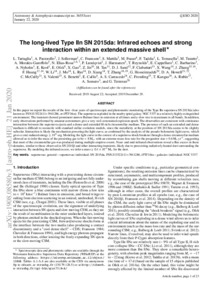The long-lived Type IIn SN 2015da: Infrared echoes and strong interaction within an extended massive shell
L. Tartaglia; A. Pastorello; J. Sollerman; C. Fransson; S. Mattila; M. Fraser; F. Taddia; L. Tomasella; M. Turatto; A. Morales-Garoffolo; N. Elias-Rosa; P. Lundqvist; J. Harmanen; T. Reynolds; E. Cappellaro; C. Barbarino; A. Nyholm; E. Kool; E. Ofek; X. Gao; Z. Jin; H. Tan; D. J. Sand; F. Ciabattari; X. Wang; J. Zhang; F. Huang; W. Li; J. Mo; L. Rui; D. Xiang; T. Zhang; G. Hosseinzadeh; D. A. Howell; C. McCully; S. Valenti; S. Benetti; E. Callis; A. S. Carracedo; C. Fremling; T. Kangas; A. Rubin; A. Somero; G. Terreran
The long-lived Type IIn SN 2015da: Infrared echoes and strong interaction within an extended massive shell
L. Tartaglia
A. Pastorello
J. Sollerman
C. Fransson
S. Mattila
M. Fraser
F. Taddia
L. Tomasella
M. Turatto
A. Morales-Garoffolo
N. Elias-Rosa
P. Lundqvist
J. Harmanen
T. Reynolds
E. Cappellaro
C. Barbarino
A. Nyholm
E. Kool
E. Ofek
X. Gao
Z. Jin
H. Tan
D. J. Sand
F. Ciabattari
X. Wang
J. Zhang
F. Huang
W. Li
J. Mo
L. Rui
D. Xiang
T. Zhang
G. Hosseinzadeh
D. A. Howell
C. McCully
S. Valenti
S. Benetti
E. Callis
A. S. Carracedo
C. Fremling
T. Kangas
A. Rubin
A. Somero
G. Terreran
EDP SCIENCES S A
Julkaisun pysyvä osoite on:
https://urn.fi/URN:NBN:fi-fe2021042824717
https://urn.fi/URN:NBN:fi-fe2021042824717
Tiivistelmä
In this paper we report the results of the first similar to four years of spectroscopic and photometric monitoring of the Type IIn supernova SN 2015da (also known as PSN J13522411+3941286, or iPTF16tu). The supernova exploded in the nearby spiral galaxy NGC 5337 in a relatively highly extinguished environment. The transient showed prominent narrow Balmer lines in emission at all times and a slow rise to maximum in all bands. In addition, early observations performed by amateur astronomers give a very well-constrained explosion epoch. The observables are consistent with continuous interaction between the supernova ejecta and a dense and extended H-rich circumstellar medium. The presence of such an extended and dense medium is difficult to reconcile with standard stellar evolution models, since the metallicity at the position of SN 2015da seems to be slightly subsolar. Interaction is likely the mechanism powering the light curve, as confirmed by the analysis of the pseudo bolometric light curve, which gives a total radiated energy greater than or similar to 10(51) erg. Modeling the light curve in the context of a supernova shock breakout through a dense circumstellar medium allowed us to infer the mass of the prexisting gas to be similar or equal to 8 M-circle dot, with an extreme mass-loss rate for the progenitor star similar or equal to 0.6 M-circle dot yr(-1), suggesting that most of the circumstellar gas was produced during multiple eruptive events. Near- and mid-infrared observations reveal a fluxexcess in these domains, similar to those observed in SN 2010jl and other interacting transients, likely due to preexisting radiatively heated dust surrounding the supernova. By modeling the infrared excess, we infer a mass greater than or similar to 0.4 x 10(-3) M-circle dot for the dust.
Kokoelmat
- Rinnakkaistallenteet [27094]
